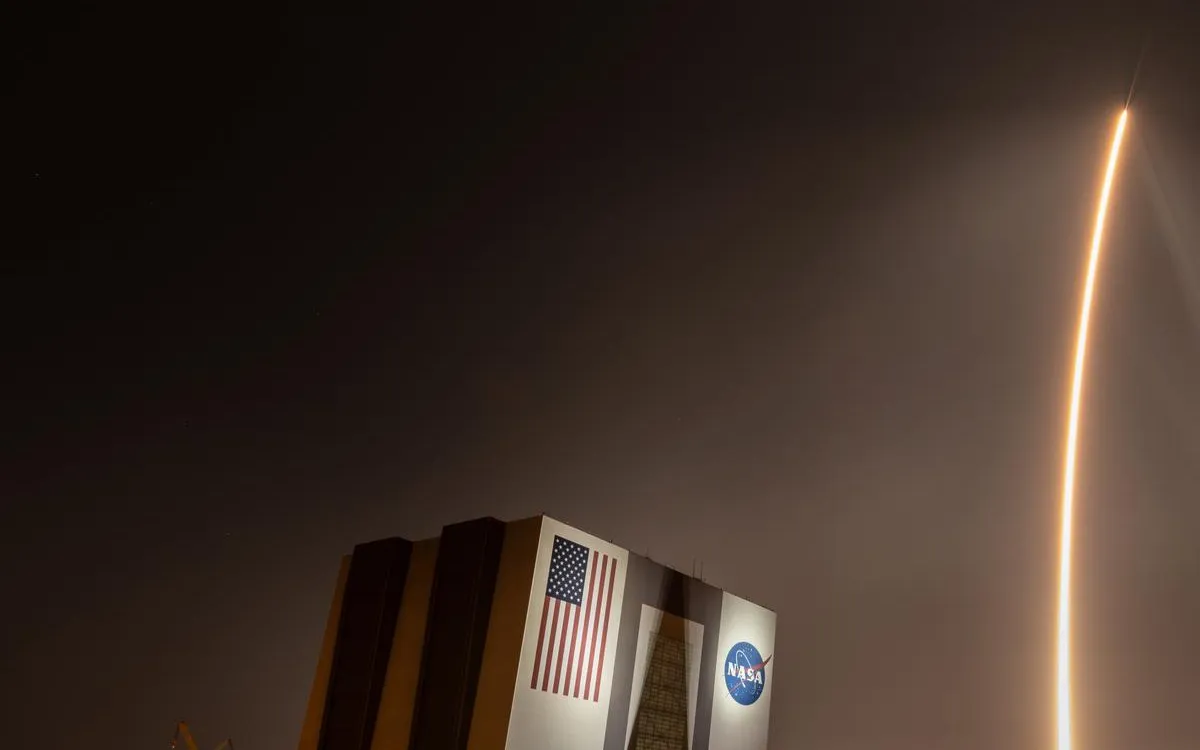
The next set of NASA science and technology demonstrations is on its way to the lunar surface, poised to gather crucial data about Earth’s nearest neighbor. These efforts are integral to paving the way for American astronauts to explore the Moon and beyond, benefiting humanity as a whole. The Intuitive Machines IM-2 mission, part of NASA’s Commercial Lunar Payload Services (CLPS) initiative and the Artemis campaign, successfully launched at 7:16 p.m. EST on February 26, 2023. The mission took off aboard a SpaceX Falcon 9 rocket from Launch Complex 39A at Kennedy Space Center in Florida.
The Intuitive Machines lunar lander is scheduled to touch down on Thursday, March 6, 2023, in the Mons Mouton region, a plateau located in the Moon’s South Pole. Janet Petro, NASA’s acting Administrator, stated, “With each CLPS mission, the United States is leading the way in expanding our reach and refining our capabilities, turning what was once dreams into reality.” She emphasized that these science and technology demonstrations are more than mere payloads; they lay the foundation for future explorers who will live and work on the Moon.
Petro further highlighted that by collaborating with American industry, NASA is driving innovation, reinforcing its leadership in space exploration, and preparing for human missions to farther destinations in the solar system, including Mars.
Upon its arrival on the Moon, the NASA CLPS investigations will focus on measuring the potential presence of volatiles or gases from lunar soil. This marks one of the first on-site demonstrations of resource utilization on the Moon. Additionally, a passive Laser Retroreflector Array located on the top deck of the lander will reflect laser light back at future orbiting or incoming spacecraft, providing them with a permanent reference point on the lunar surface. Other technological instruments included in this mission will showcase a robust surface communications system and deploy a propulsive drone designed for hopping across the lunar terrain.
Alongside the IM-2 mission, NASA’s Lunar Trailblazer spacecraft launched as a rideshare. This mission aims to enter lunar orbit and map the distribution of various forms of water on the Moon. The Lunar Trailblazer will investigate where the Moon’s water is located, its forms, and how it changes over time. The observations collected during its two-year prime mission will enhance our understanding of water cycles on airless bodies throughout the solar system, while also supporting future human and robotic missions by identifying accessible water sources.
The NASA Artemis campaign focuses on conducting further scientific research to better understand planetary processes and evolution, search for evidence of water and other resources, and support long-term, sustainable human exploration. The instruments launched aboard the IM-2 mission include:
Polar Resources Ice Mining Experiment-1 (PRIME-1): This experiment explores the Moon’s subsurface to identify potential lunar resources. It employs two key instruments: the Regolith and Ice Drill for Exploring New Terrains, which collects lunar soil samples, and the Mass Spectrometer Observing Lunar Operations, which analyzes these samples for volatile compounds. Laser Retroreflector Array (LRA): This collection of eight retroreflectors will facilitate precision laser ranging, serving as a permanent location marker on the Moon for decades. Micro Nova Hopper: Funded by NASA’s Space Technology Mission Directorate Tipping Point initiative, this autonomous drone, named Grace, will survey the lunar surface and send scientific data back to the lander. Nokia Lunar Surface Communications System (LSCS): Developed with funding from NASA’s Tipping Point initiative, this 4G/LTE system will demonstrate cellular communications between the Intuitive Machines lander, a Lunar Outpost rover, and the Micro Nova hopper.The LSCS is designed to transmit high-definition video, command-and-control messages, and telemetry data, showcasing an advanced communication solution for future lunar infrastructure and beyond.
For more detailed information on NASA’s Commercial Lunar Payload Services (CLPS) initiative, visit NASA's official website.
For further inquiries, contact:
Karen Fox / Jasmine Hopkins
Headquarters, Washington
202-358-1600 / 321-432-4624
karen.c.fox@nasa.gov / jasmine.s.hopkins@nasa.gov
Natalia Riusech / Nilufar Ramji
Johnson Space Center, Houston
281-483-5111
natalia.s.riusech@nasa.gov / nilufar.ramji@nasa.gov